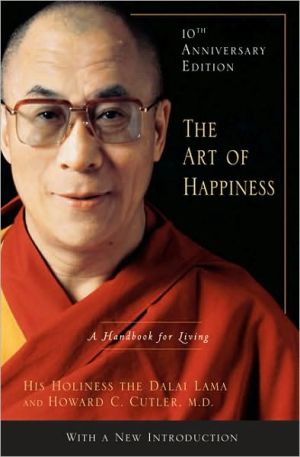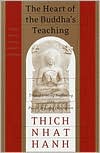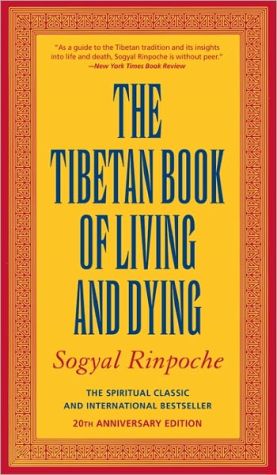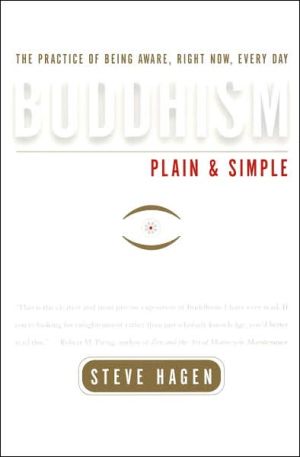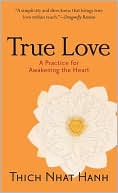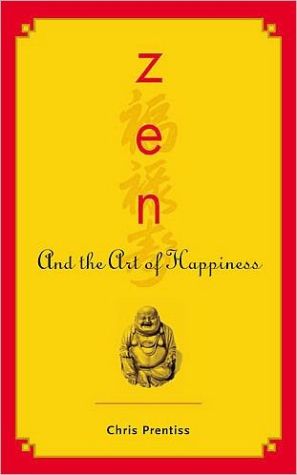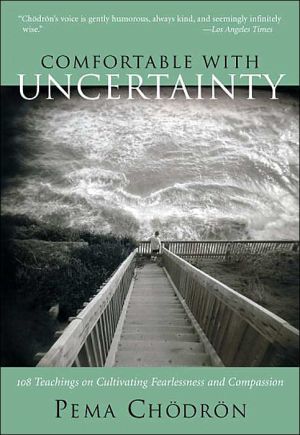The Places That Scare You: A Guide to Fearlessness in Difficult Times
We always have a choice, Pema Chodron teaches: We can let the circumstances of our lives harden us and make us increasingly resentful and afraid, or we can let them soften us and make us kinder. Pema's previous works provided the inspiration and guidance to confront the problems and difficulties that life throws our way. Here she provides the specific tools to deal with them - to cultivate the awakened, compassionate ability to open our hearts and minds to our own suffering and that of...
Search in google:
In The Places That Scare You, Pema Chödrön continues the teachings of When Things Fall Apart, showing how at the core of the most painful experiences lie the seeds of spiritual awakening. Here she presents key teachings on recognizing and cultivating the "soft spot" that is the gateway to compassion and open-heartedness. In this book she discusses: The four great catalysts of awakening, and how to integrate them into our lives Why the "soft spot" is necessary for spiritual awakening The basic goodness that is inherently ours How the three noble principles can enrich everything we do The maitri meditation that multiplies love Why an attitude of "don't know" can be wiser than the world's greatest spiritual teachings How to keep the heart open with equal fearlessness to both heartache and delight Publishers Weekly American Tibetan Buddhist nun Chodron (When Things Fall Apart) teaches an intense form of meditation in which readers are encouraged to become "warrior-bodhisattvas," those who courageously confront suffering. Warrior-bodhisattvas, according to Chodron, are willing to have their inner selves broken, while keeping their minds and hearts from shutting down. They take on suffering with compassion and loving-kindness, working through their own emotions of fear or anger to help alleviate others' pain. Chodron highlights six traditional paramitas to model (generosity, discipline, patience, enthusiasm, meditation and unconditional wisdom) and cautions that ego, self-deception, unforgiveness and a grasping for permanence all present barriers to compassion. True meditation cultivates the qualities of steadfastness, clarity of vision and attention to the present moment. Despite the title, this book is more about generating compassion than facing fears. A few humorous vignettes are interspersed with the deeply philosophical text, such as when Chodron describes discovering her boyfriend in an intimate embrace with another woman. She tried to throw something at the couple, but the thing she picked up was a priceless piece of pottery that belonged to their millionaire host. "The absurdity of the situation totally cut through my rage," she explains, noting that many times "wisdom is inherent in emotions." Moments such as these mitigate the intensity of this highly cerebral book, which will offer meaty reflections for the serious practitioner, but less guidance for the mere bookstore Buddhist. (Sept.) Forecast: This title will receive some terrific exposure this fall. Shambhala Sun will excerpt twochapters and feature Chodron on the cover of its August/September issue, and New Age Journal will run an excerpt in September. In the piece de resistance, O magazine will run a substantial profile on Chodron in the October issue. Copyright 2001 Cahners Business Information.
\ \ Chapter One\ \ \ The Excellence\ of Bodhichitta\ \ \ It is only with the heart that one can see rightly;\ what is essential is invisible to the eye.\ —ANTOINE DE SAINT-EXUPÉRY\ \ \ When I was about six years old I received the essential bodhichitta teaching from an old woman sitting in the sun. I was walking by her house one day feeling lonely, unloved, and mad, kicking anything I could find. Laughing, she said to me, "Little girl, don't you go letting life harden your heart."\ Right there, I received this pith instruction: we can let the circumstances of our lives harden us so that we become increasingly resentful and afraid, or we can let them soften us and make us kinder and more open to what scares us. We always have this choice.\ If we were to ask the Buddha, "What is bodhichitta?" he might tell us that this word is easier to understand than to translate. He might encourage us to seek out ways to find its meaning in our own lives. He might tantalize us by adding that it is only bodhichitta that heals, that bodhichitta is capable of transforming the hardest of hearts and the most prejudiced and fearful of minds.\ Chitta means "mind" and also "heart" or "attitude." Bodhi means "awake," "enlightened," or "completely open." Sometimes the completely open heart and mind of bodhichitta is called the soft spot, a place as vulnerable and tender as an open wound. It is equated, in part, with our ability to love. Even the cruelest people have this soft spot. Even the most vicious animals love their offspring. As Trungpa Rinpoche put it, "Everybody loves something, even if it's only tortillas."\ Bodhichitta is also equated, in part, with compassion—our ability to feel the pain that we share with others. Without realizing it we continually shield ourselves from this pain because it scares us. We put up protective walls made of opinions, prejudices, and strategies, barriers that are built on a deep fear of being hurt. These walls are further fortified by emotions of all kinds: anger, craving, indifference, jealousy and envy, arrogance and pride. But fortunately for us, the soft spot—our innate ability to love and to care about things—is like a crack in these walls we erect. It's a natural opening in the barriers we create when we're afraid. With practice we can learn to find this opening. We can learn to seize that vulnerable moment—love, gratitude, loneliness, embarrassment, inadequacy—to awaken bodhichitta.\ An analogy for bodhichitta is the rawness of a broken heart. Sometimes this broken heart gives birth to anxiety and panic, sometimes to anger, resentment, and blame. But under the hardness of that armor there is the tenderness of genuine sadness. This is our link with all those who have ever loved. This genuine heart of sadness can teach us great compassion. It can humble us when we're arrogant and soften us when we are unkind. It awakens us when we prefer to sleep and pierces through our indifference. This continual ache of the heart is a blessing that when accepted fully can be shared with all.\ The Buddha said that we are never separated from enlightenment. Even at the times we feel most stuck, we are never alienated from the awakened state. This is a revolutionary assertion. Even ordinary people like us with hang-ups and confusion have this mind of enlightenment called bodhichitta. The openness and warmth of bodhichitta is in fact our true nature and condition. Even when our neurosis feels far more basic than our wisdom, even when we're feeling most confused and hopeless, bodhichitta—like the open sky—is always here, undiminished by the clouds that temporarily cover it.\ Given that we are so familiar with the clouds, of course, we may find the Buddha's teaching hard to believe. Yet the truth is that in the midst of our suffering, in the hardest of times, we can contact this noble heart of bodhichitta. It is always available, in pain as well as in joy.\ A young woman wrote to me about finding herself in a small town in the Middle East surrounded by people jeering, yelling, and threatening to throw stones at her and her friends because they were Americans. Of course, she was terrified, and what happened to her is interesting. Suddenly she identified with every person throughout history who had ever been scorned and hated. She understood what it was like to be despised for any reason: ethnic group, racial background, sexual preference, gender. Something cracked wide open and she stood in the shoes of millions of oppressed people and saw with a new perspective. She even understood her shared humanity with those who hated her. This sense of deep connection, of belonging to the same family, is bodhichitta.\ Bodhichitta exists on two levels. First there is unconditional bodhichitta, an immediate experience that is refreshingly free of concept, opinion, and our usual all-caught-upness. It's something hugely good that we are not able to pin down even slightly, like knowing at gut level that there's absolutely nothing to lose. Second there is relative bodhichitta, our ability to keep our hearts and minds open to suffering without shutting down.\ Those who train wholeheartedly in awakening unconditional and relative bodhichitta are called bodhisattvas or warriors—not warriors who kill and harm but warriors of nonaggression who hear the cries of the world. These are men and women who are willing to train in the middle of the fire. Training in the middle of the fire can mean that warrior-bodhisattvas enter challenging situations in order to alleviate suffering. It also refers to their willingness to cut through personal reactivity and self-deception, to their dedication to uncovering the basic undistorted energy of bodhichitta. We have many examples of master warriors—people like Mother Teresa and Martin Luther King—who recognized that the greatest harm comes from our own aggressive minds. They devoted their lives to helping others understand this truth. There are also many ordinary people who spend their lives training in opening their hearts and minds in order to help others do the same. Like them, we could learn to relate to ourselves and our world as warriors. We could train in awakening our courage and love.\ There are both formal and informal methods for helping us to cultivate this bravery and kindness. There are practices for nurturing our capacity to rejoice, to let go, to love, and to shed a tear. There are those that teach us to stay open to uncertainty. There are others that help us to stay present at the times that we habitually shut down.\ Wherever we are, we can train as a warrior. The practices of meditation, loving-kindness, compassion, joy, and equanimity are our tools. With the help of these practices, we can uncover the soft spot of bodhichitta. We will find that tenderness in sorrow and in gratitude. We will find it behind the hardness of rage and in the shakiness of fear. It is available in loneliness as well as in kindness.\ Many of us prefer practices that will not cause discomfort, yet at the same time we want to be healed. But bodhichitta training doesn't work that way. A warrior accepts that we can never know what will happen to us next. We can try to control the uncontrollable by looking for security and predictability, always hoping to be comfortable and safe. But the truth is that we can never avoid uncertainty. This not knowing is part of the adventure, and it's also what makes us afraid.\ Bodhichitta training offers no promise of happy endings. Rather, this "I" who wants to find security—who wants something to hold on to—can finally learn to grow up. The central question of a warrior's training is not how we avoid uncertainty and fear but how we relate to discomfort. How do we practice with difficulty, with our emotions, with the unpredictable encounters of an ordinary day?\ All too frequently we relate like timid birds who don't dare to leave the nest. Here we sit in a nest that's getting pretty smelly and that hasn't served its function for a very long time. No one is arriving to feed us. No one is protecting us and keeping us warm. And yet we keep hoping mother bird will arrive.\ We could do ourselves the ultimate favor and finally get out of that nest. That this takes courage is obvious. That we could use some helpful hints is also clear. We may doubt that we're up to being a warrior-in-training. But we can ask ourselves this question: "Do I prefer to grow up and relate to life directly, or do I choose to live and die in fear?"\ All beings have the capacity to feel tenderness—to experience heartbreak, pain, and uncertainty. Therefore the enlightened heart of bodhichitta is available to us all. The insight meditation teacher Jack Kornfield tells of witnessing this in Cambodia during the time of the Khmer Rouge. Fifty thousand people had become communists at gunpoint, threatened with death if they continued their Buddhist practices. In spite of the danger, a temple was established in the refugee camp, and twenty thousand people attended the opening ceremony. There were no lectures or prayers but simply continuous chanting of one of the central teachings of the Buddha:\ \ \ Hatred never ceases by hatred\ But by love alone is healed.\ This is an ancient and eternal law.\ \ \ Thousands of people chanted and wept, knowing that the truth in these words was even greater than their suffering.\ Bodhichitta has this kind of power. It will inspire and support us in good times and bad. It is like discovering a wisdom and courage we do not even know we have. Just as alchemy changes any metal into gold, bodhichitta can, if we let it, transform any activity, word, or thought into a vehicle for awakening our compassion.\ \ \ Excerpted from The Places That Scare You by PEMA CHÖDRÖN. Copyright © 2001 by Pema Chödrön. Excerpted by permission. All rights reserved. No part of this excerpt may be reproduced or reprinted without permission in writing from the publisher. \ \ \ \
Acknowledgmentsix Prologue1 1. The Excellence of Bodhichitta3 2. Tapping into the Spring9 3. The Facts of Life17 4. Learning to Stay23 5. Warrior Slogans31 6. Four Limitless Qualities37 7. Loving-Kindness41 8. Compassion49 9. Tonglen55 10. Finding the Ability to Rejoice61 11. Enhancing the Training in Joy67 12. Thinking Bigger69 13. Meeting the Enemy75 14. Fresh Start81 15. Strength83 16. Three Kinds of Laziness89 17. Bodhisattva Activity93 18. Groundlessness99 19.Heightened Neurosis105 20. When the Going Gets Rough109 21. The Spiritual Friend113 22. The In-Between State119 Concluding Aspiration123 APPENDIX: PRACTICES The Mind-Training Slogans of Atisha125 The Four Limitless Ones Chant129 Loving-Kindness Practice130 Compassion Practice131 The Three-Step Aspiration132 Bibliography133 Resources137
\ From Barnes & NobleAccording to American Buddhist nun Pema Chodron, the secret to cultivating a compassionate heart and an enlightened mind lies in facing what we most fear.\ \ \ \ \ Publishers WeeklyAmerican Tibetan Buddhist nun Chodron (When Things Fall Apart) teaches an intense form of meditation in which readers are encouraged to become "warrior-bodhisattvas," those who courageously confront suffering. Warrior-bodhisattvas, according to Chodron, are willing to have their inner selves broken, while keeping their minds and hearts from shutting down. They take on suffering with compassion and loving-kindness, working through their own emotions of fear or anger to help alleviate others' pain. Chodron highlights six traditional paramitas to model (generosity, discipline, patience, enthusiasm, meditation and unconditional wisdom) and cautions that ego, self-deception, unforgiveness and a grasping for permanence all present barriers to compassion. True meditation cultivates the qualities of steadfastness, clarity of vision and attention to the present moment. Despite the title, this book is more about generating compassion than facing fears. A few humorous vignettes are interspersed with the deeply philosophical text, such as when Chodron describes discovering her boyfriend in an intimate embrace with another woman. She tried to throw something at the couple, but the thing she picked up was a priceless piece of pottery that belonged to their millionaire host. "The absurdity of the situation totally cut through my rage," she explains, noting that many times "wisdom is inherent in emotions." Moments such as these mitigate the intensity of this highly cerebral book, which will offer meaty reflections for the serious practitioner, but less guidance for the mere bookstore Buddhist. (Sept.) Forecast: This title will receive some terrific exposure this fall. Shambhala Sun will excerpt twochapters and feature Chodron on the cover of its August/September issue, and New Age Journal will run an excerpt in September. In the piece de resistance, O magazine will run a substantial profile on Chodron in the October issue. Copyright 2001 Cahners Business Information.\ \ \ Library JournalChodron, a student of Chogyam Trungpa, is well known for her clear and inspiring books on spiritual practice (e.g., The Wisdom of No Escape). Here she once again presents Tibetan Buddhist wisdom in a clear, engaging, and undiluted way, making it useful and relevant for newcomers and longtime practitioners alike. This time her focus is on bodhichitta, a concept that roughly translates as "open heart" or "awakened mind." As the text points out, this is a term more easily understood than translated, finding its ground in activities that embody compassion, tenderness, and awareness. In a series of short chapters, the reader is introduced to a number of ideas found in Tibetan Buddhist bodhichitta practice and is given practical exercises for daily life. Her clear and simple descriptions guide the reader through these powerful and sometimes difficult practices. Chodron has once again proven herself to be one of the very best working in this crowded field. Recommended for all collections. Mark Woodhouse, Elmira Coll. Lib., NY Copyright 2001 Cahners Business Information.\ \

